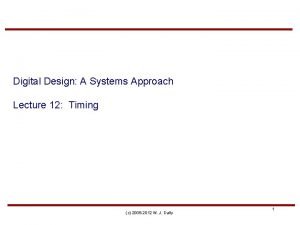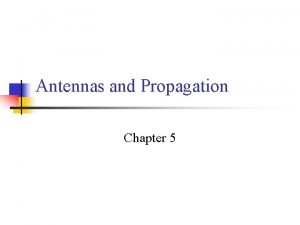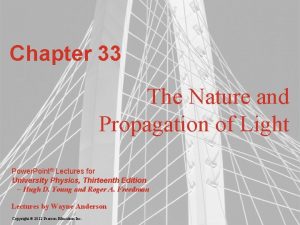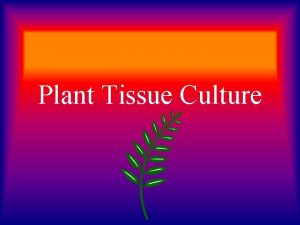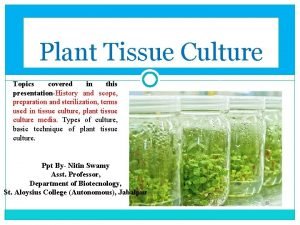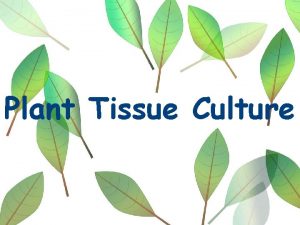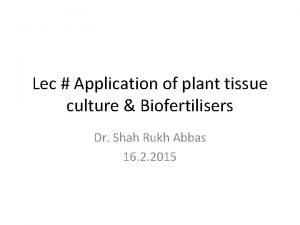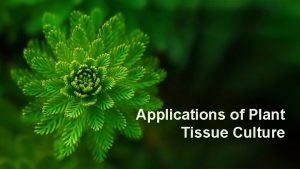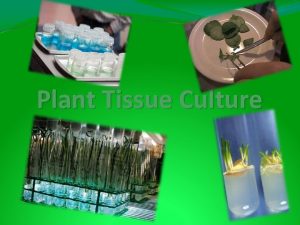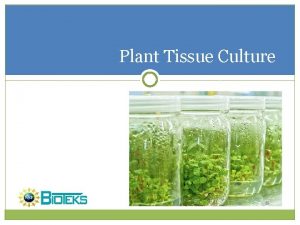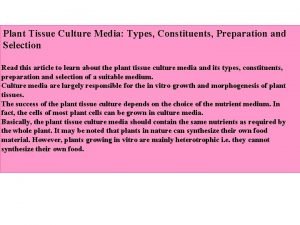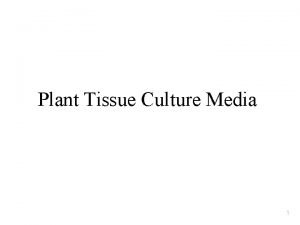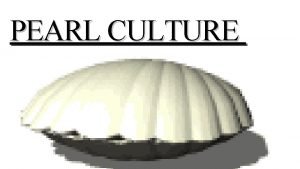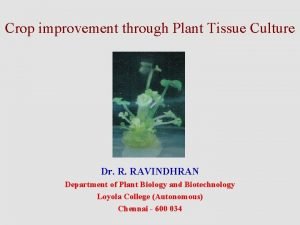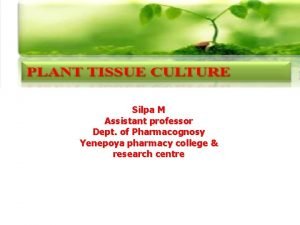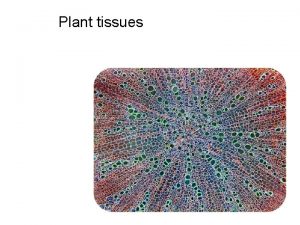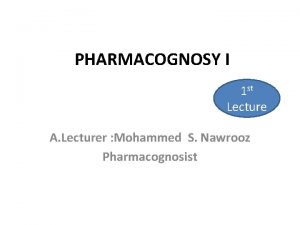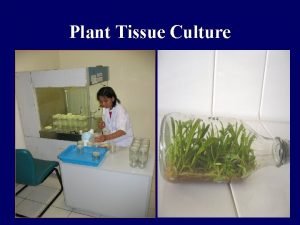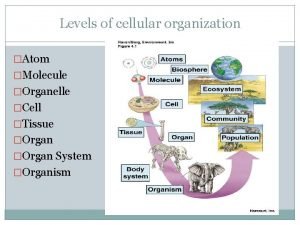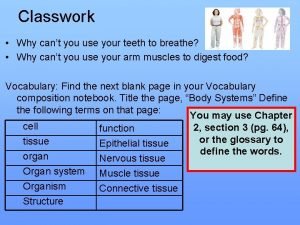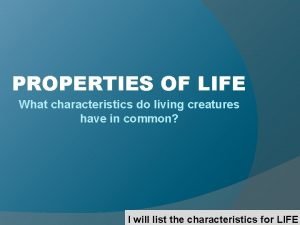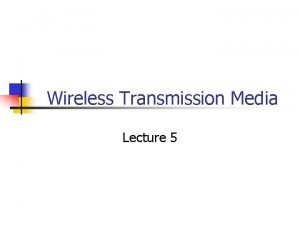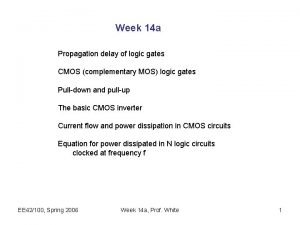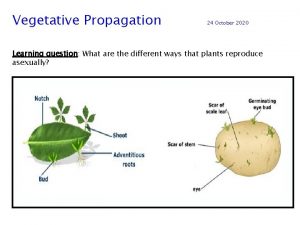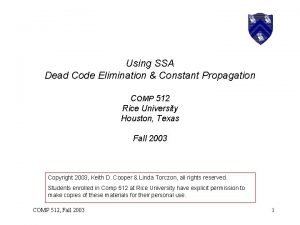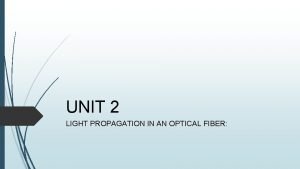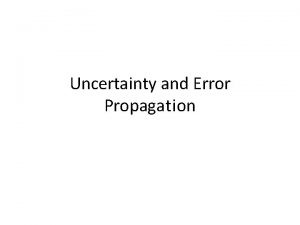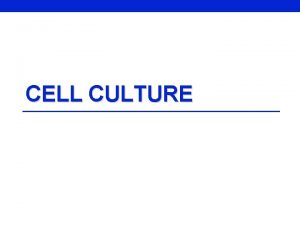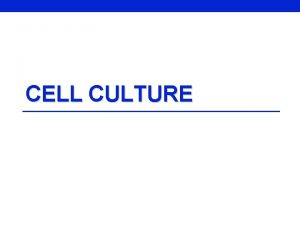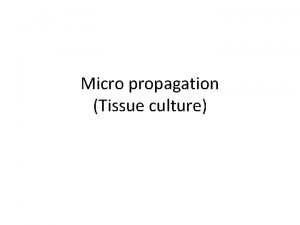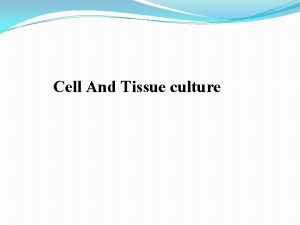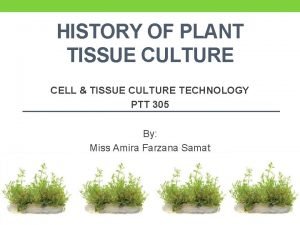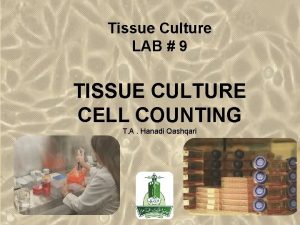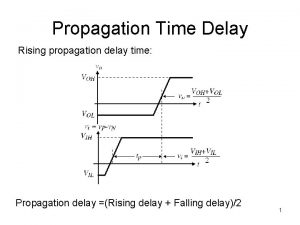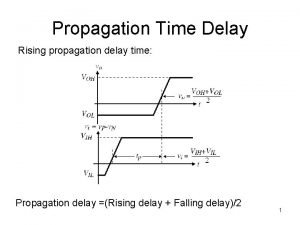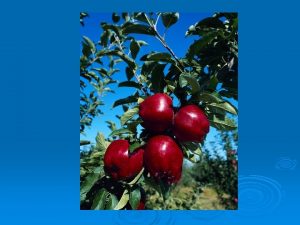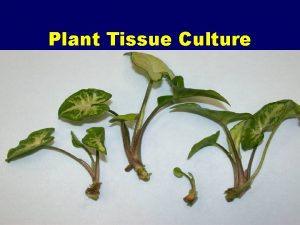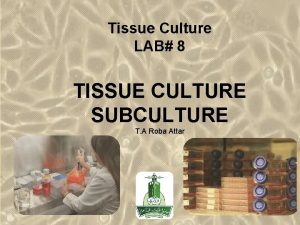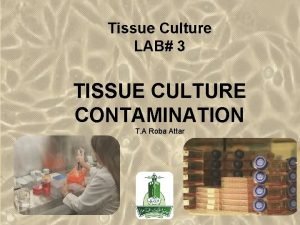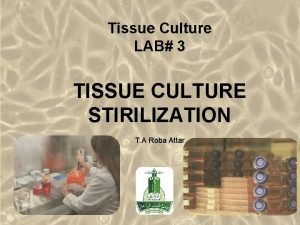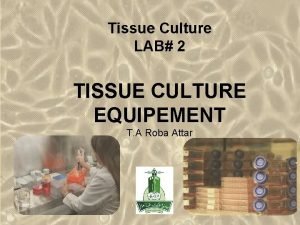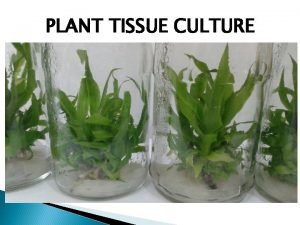Cell and tissue culture Cell culture propagation of











































- Slides: 43

Cell and tissue culture

Cell culture = propagation of cells outside the organism = in vitro (Cells in the organism = in vivo) ADVANTAGES: • cellular environment can be manipulated • well defined cell type • large quantities of cells can be obtained • many cellular functions can be investigated • animal experiments can be replaced • living cells can be tested • human cells can be tested DISADVANTAGES: • does not mimic the complexity of the human body • spontanous evolution 2

TYPES OF CULTURED CELLS: • primary culture • cell line Ø finite continuous Ø • cell strain 3

Primary culture • Cells derived directly from tissues • A culture from the time of isolation until its first subculture First developed in 1907: 1 day spinal cord explant + lymphatic fluid axons grow in culture!

cultured neuron extending processes

Cell line • Derived from primary culture via subcultivation (passage) dissociate cells tissue explant medium plate cells dish • Grow and divide while adhering (monolayer) to plastic dishes • Require growth factor for growth • Passaging: after physical or enzymatic dissociation of monolayer cultures the cells are reseeded in lower density 6

Cell line Finite cell line • Finite lifespan • A cell line that survives for a fixed number of population doublings, usually ~40– 60 (Hayflick limit), before senescing and ceasing proliferation.

Cell line Features: • • • Continuous cell line Immortal (indefinite lifespan, over 100 population doublings) Genetic abnormalities accumulate (transformed cells) Unlimited growth Loss of contact inhibition Loss of adherence dependency (suspension) injected in mice may form tumor Transformation can be spontanous or induced by viruses, carcinogens or radiation May derive: • from finite cell line (in vitro transformation) – e. g. NIH 3 T 3, CHO • from tumors (in vivo transformation) – e. g. He. La

Cell strain • A subpopulation of cell lines that have been purified by physical separation, selection or cloning • Which has specific defined characteristics e. g. marker chromosome, virus resistance, antigen expression

normal cells SEM transformed cells

Cell cultures can be obtained e. g. from cell banks where these cultures are kept frozen (-196 °C in liquid nitrogen)

Density of the culture influences the cell shape

Density of the culture influences the cell shape

Requirements of cell cultures Physical parameters Biological parameters • Temperature • O 2/CO 2. • humidity • ASEPTIC conditions Chemical parameters • Cell density • Co-culture • Metabolites • Feeder cell layer • defined medium • serum (growth factors, hormones) • coat on culture surface (collagen, gelatine) • p. H • osmolarity

Laminar box (laminar flow cabinet) is a carefully enclosed bench designed to prevent contamination of biological samples or any particle sensitive materials.

CO 2 Incubator The incubator maintains optimal temperature, humidity and other conditions such as the carbon dioxide (CO 2) and oxygen content of the atmosphere inside.

Plasticwares for cell culture

Inverted Microscope Light source Objectives in routine laboratories for live cell inspection 18

R 1 ES cells on fibroblast feeder layer D 3 ES (embryonic stem) cells on fibroblast feeder layer

He. La 53 MONOLAYER CELL CULTURE Adherent cells, they need surface for proliferation. These are normal cells except hematopoetic cells. Tumor cells may grow in monolayer, too. myeloma cells SUSPENSION CELL CULTURE Non-adherent, floating, generally hemopatopoetic or transformed, tumor cells, they do not need special surface for proliferation.

Cell count in function of time Confluent culture

Cell count in function of time 3. Stationary phase /plateau without changing medium 2. log phase Cell count subculturing 1. lag phase time 22

ENVIRONMENTAL INTERACTIONS • Infections (viruses, bacteria, parasites) • Toxicology • Immunology • Carcinogenesis • Biotransformation of xenobiotics BIOTECHNOLOGY/ TISSUE ENGINEERING • Cytokines/growth factors, hormones, antibody production • Arteficial tissues GENETICS • Transformation • Cell fusion • Cell cycle BIOCHEMISTRY • DNA transcription • RNA metabolism • Protein synthesis • Intermediate metabolism CELL BIOLOGY • Cell-cell and cell-matrix interactions • Gene expression • Cell proliferation • Differentiation • Cell migration, invasion

Slide 9. He. La monolayer (human cervical cancer)(MGG) cytoplasm nucleus No contact inhibition Cell morphology changes with cell density!! 100% aneuploid.

Use and perspectives of cell culture

Pluripotent Unipotent


i. PS (induced pluripotent stem) cells

Artificial human tissues and organs • • • Blood vessels - aorta Liver Bone Cartilage Skin Retina Requirements of tissue engineering 29

Human epidermal epithelial cell cultures with different density and different duration in culture. 30 Cultured epidermal autograft (e. g. Epicel R)

Therapeutic use of human epidermal epithelial cell culture. This photo was taken 5 years after the transplantation.

Generation of artificial teeth or a scaffold printed in 3 D scaffold may comprise compounds that are chemotactic, osteogenic, dentinogenic, amelogenic, or cementogenic.

Diagnosis : Amniocentesis – genetic study of the embryo

Ex vivo gene therapy In vivo gene therapy

Ex vivo gene therapy in dentristry

Facultative slides 36

The immortal life of Henrietta Lacks born Loretta Pleasant in 1920 • 1951 Tissue were taken without her knowledge • 1952 He. La cells were used to develop polio vaccine • 1955 Isolation of a single cell for cloning • 1960 He. La went to space before any astronaut • 1984 He. La was used to prove that HPV infection causes cancer George Otto Gey • 1986 Mechanism of HIV infection were studied • 1989 Telomerase were described in He. La • 1993 Tuberculosis was studied • 2013 Whole genome data of He. La were published 37

History of human embryonic stem cell research 1998 – James Thomson isolated cells from the inner cell mass of the early embryo and developed the first human embryonic stem cell lines Derivation of the H 9 cell line. (A) Inner cell mass–derived cells attached to mouse embryonic fibroblast feeder layer after 8 days of culture, 24 hours before first dissociation. Scale bar, 100 μm. (B) H 9 colony. Scale bar, 100 μm. (C) H 9 cells. Scale bar, 50 μm. (D) Differentiated H 9 cells, cultured for 5 days in the absence of mouse embryonic fibroblasts, but in the presence of human LIF (20 ng/ml; Sigma). Scale bar, 100 μm. Science 06 Nov 1998: 38

Organ on a chip technique § Microfluidic chamber lined by living human cells § Mimics the interconnectedness of organs within humans § Fields of application: - disease modelling; - drug development; - personalized medicine https: //wyss. harvard. edu/technology/human-organs-on-chips/ http: //www. thelatestnews. com/organ-chip-breakthrough-replace-lab-animals/ 39

A tissue-friendly scaffold covered with self-cells is not immunogenic. 40

The hydrogel embedded cells are printed in 3 D 41

First artifical trachea 42

 How is aerolar tissue different than aerenchyma tissue?
How is aerolar tissue different than aerenchyma tissue? Propagation delay and contamination delay
Propagation delay and contamination delay Antennas and propagation
Antennas and propagation Nature and propagation of light
Nature and propagation of light Plant tissue culture terminology
Plant tissue culture terminology Plant tissue culture ppt
Plant tissue culture ppt Protoplast culture
Protoplast culture Application of tissue culture
Application of tissue culture Conclusion for tissue culture
Conclusion for tissue culture African violet tissue culture
African violet tissue culture Application of plant tissue culture in pharmacognosy
Application of plant tissue culture in pharmacognosy Ms media preparation
Ms media preparation Auxin in tissue culture
Auxin in tissue culture Artificial pearl culture
Artificial pearl culture Plant tissue culture
Plant tissue culture Bergmann's plating technique
Bergmann's plating technique Laboratory requirements for plant tissue culture ppt
Laboratory requirements for plant tissue culture ppt Pharmacognosy lecture
Pharmacognosy lecture Seed culture ppt
Seed culture ppt Atom-molecule-cell-organ system-organelle
Atom-molecule-cell-organ system-organelle Connective tissue
Connective tissue Cell tissue organ organ system organism
Cell tissue organ organ system organism Cells are the building blocks of all living things
Cells are the building blocks of all living things Cell tissue organ system body
Cell tissue organ system body Cell tissue
Cell tissue Material culture examples
Material culture examples Continuous culture and batch culture
Continuous culture and batch culture American vs indian culture
American vs indian culture Uses of selenite f broth
Uses of selenite f broth Folk culture and popular culture venn diagram
Folk culture and popular culture venn diagram Chapter 4 folk and popular culture
Chapter 4 folk and popular culture Anerobic media
Anerobic media Homework due today
Homework due today Carpet culture method
Carpet culture method Lawn culture method
Lawn culture method Surface culture deep culture and esol
Surface culture deep culture and esol Wireless transmission media examples
Wireless transmission media examples How to calculate propagation delay in logic gates
How to calculate propagation delay in logic gates Vegetative propagation
Vegetative propagation Sparse conditional constant propagation
Sparse conditional constant propagation Optical fiber light propagation
Optical fiber light propagation Propagation of error in division
Propagation of error in division Uncertainty multiplication and division
Uncertainty multiplication and division Sparse conditional constant propagation
Sparse conditional constant propagation

